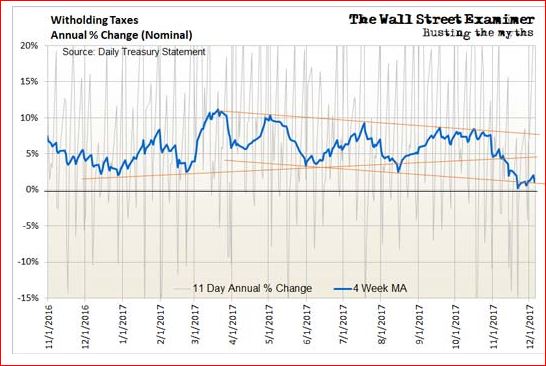Lee Adler posted....
Despite the new highs and the great growth and yada yada yada ....we are on the brink of a
recession. I have the numbers to prove it. And the numbers don't lie. Data on Federal tax
collections comes to us in real time every day, courtesy of the US Treasury. This is
unmassaged real data, not the endlessly finagled economic data put out by various other
US government agencies. Tracking the tax data regularly enables us to see how the US
economy is actually behaving, versus how the government wants you to think it's behaving.
That's important because the current data tells us something really big about the US
economy that nobody knows yet. It won't show up in the official GDP data for months, but
it could rock the markets and cause the Fed to change course. Here's the big news.

- 51960.JPG (49 KiB) Viewed 5699 times
Withholding tax collections plunged in the second half of November, suggesting that the
US is on the brink of, if not entering, recession. The drop in withholding not only broke
a yearlong uptrend, but it has established a downtrend. After adjusting for wage inflation,
the year to year comparison is now slightly negative. It means that the US is barely hanging
above recession. It will take a couple of months more before we know for sure one way or
the other, depending on how strong or weak collections are. Officially it takes 2 quarters
in a row of falling GDP for the NBER to call a recession. By the time that second GDP report
comes out, months after the tax data has already tipped us off, the recession will have
already been under way for 7-9 months. But the Fed wouldn't materially loosen policy until
then. There's no guarantee that the numbers will go negative in the short run. Consequently,
we should not expect any loosening of policy until at least late 2018. That's plenty of time
for tight monetary policy, euphemistically named "normalization," to cause considerable
damage to stock prices. The Fed started real tightening in October. It has begun to shrink
its balance sheet. That will pull money out of the banking system. The program is starting
very gradually, with only baby steps that are barely impacting the markets. But over time
it will increasingly drain money from the pool of cash available to purchase stocks and bonds.
This has set up the conditions for a bearish stock market, but as I have been emphasizing,
it won't necessarily trigger them immediately. As you know if you have been following along
with these reports, we've been looking to January-February as the likely window for a market
high. Because the tax data is real time hard data, it gives us an edge. Economic data is
lagged and manipulated. It often takes another month, or several months, before the economic
data reflects what the tax data has already shown. With the benefit of knowing what the tax
data tells us about the actual state of the economy, we can move in advance of the crowd.
We can more easily identify the false narrative, or at least the old narrative that is no
longer true. The strength in the tax data prior to November told us that the economy was
heating up. That told us that the Fed would tighten. These cycles tend to last a few years.
During that time the Fed has difficulty because the economy defies conventional wisdom and
continues to heat up as interest rates rise. Bear markets thrive in these environments. Each
time the market sells off, the bottom is declared and dip buyers come in. But the ensuing
rally falls short of the last one and the market rolls over again. Early in the cycle the
opportunity usually presents itself to place judicious short positions on both individual
industries and the broad market. I give suggestions for those based on technical analysis
in the Wall Street Examiner Pro Trader Daily Trades List.

- 51636.JPG (79.78 KiB) Viewed 5699 times
Total withholding tax collections are available to us virtually in real time in the US
Treasury's Daily Treasury Statements, released with just a one day lag, which makes them
an excellent analytical resource. However, they are extremely volatile day to day so I
rely more on a monthly moving average of the 11 day total collections, comparing that
with the prior year. Smoothing sacrifices a bit of timeliness to get a clearer picture
of the trend without losing too much of the edge that the daily data provides. Unfortunately,
I have found even the 11 day total data too noisy for meaningful comparison so I've had
to resort to additional smoothing. As a result the smoothed data is a little slow, so I
also look at raw data trends to get a better sense of timing. Withholding tax collections
are now signaling that the US economy is on the cusp of possible recession. The annual
growth rate slipped to +2.2% as of December 5. That's before inflation. Average weekly
earnings have lately been growing at somewhat north of 2.5% (but there's no inflation,
ahem). So applying a 2.5% wage inflation factor indicates that real growth is now slightly
negative.
Do that 2 quarters in a row and it would be an official recession. The Fed wouldn't loosen
policy until at least then and possibly later. Furthermore, there's no guarantee that the
numbers will go negative in the short run. Consequently we should not expect any loosening
of liquidity probably until at least October, and maybe later. This weakening in withholding
tax collections followed 2 very strong months in September-October where they were gaining
around 8-9% on a year to year basis. At the same time, we were seeing canaries in the coal
mine in other tax series, particularly excise taxes, that told us that there was something
rotten going on. This supports one of my pet sayings. "Employers are always the last to get
the news"-along with investors! The big gains over the summer were probably more about huge
gains in withholding from those at the very top of the income spectrum, and not about broad
based recovery. Big percentage gains by those earning millions skew the topline totals to
obscure weak gains, if any, in the middle of the spectrum.
That's bearish because it keeps the Fed on its tightening course. Markets top out when the
economic news is good because that's when central banks pull the punchbowl. That process
is under way again. We already know what the outcome will be. It is only a matter of time.